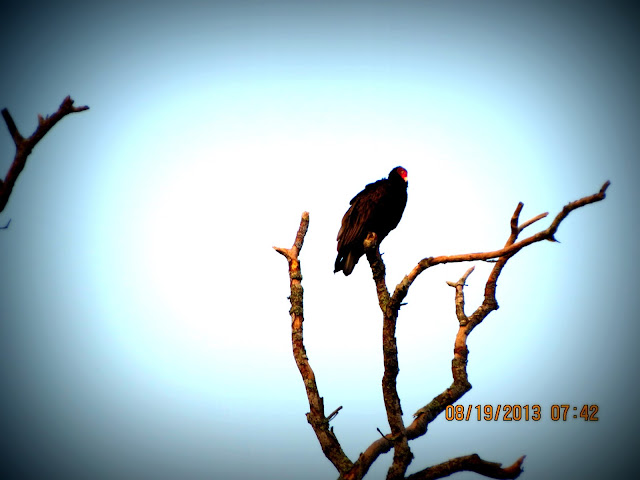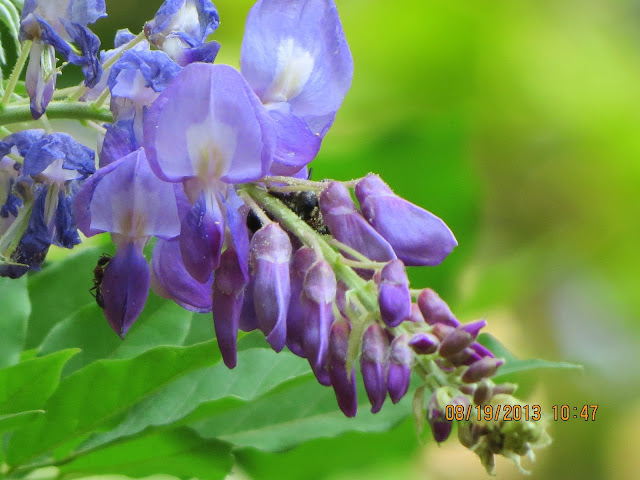"There’s the core, where the pressure and temperature are so great that atoms of hydrogen are fused into helium. Every second, 600 million tons of material go through this conversion, releasing vast amounts of gamma radiation. This is the hottest natural place in the Solar System, reaching temperatures of 15 million degrees Celsius. Photons generated at the core of the Sun are emitted and absorbed countless times over thousands of years on their journey to reach the surface."
.........http://www.universetoday.com/103634/how-hot-is-the-sun/
(Please see link for complete Report)
How Hot is the Sun?
by on JULY 22, 2013
Hi Everybody!!Yes, it is Hot, but 15 million degrees? A little too Hot for me on the Sun so I will try to hang around the Earth a little longer! The fireball Sunrise came racing through the trees like a raging forest fire. What a great morning as an old friend came by at coffee time. He is in your photostudy tonight. Your infostudy is on Wisteria from Wikipedia. I chased bumblebees around the altheas all day and caught the sunset in the woods. The Sun is setting on these August Days-soon it will be September. Enjoy!
From the Google Index:
Turkey Vulture - Wikipedia, the free encyclopedia
en.wikipedia.org/wiki/Turkey_Vulture
The Turkey Vulture (Cathartes aura), also known in some North American regions as the turkey buzzard (or just buzzard), and in some areas of the Caribbean as ...
This flower normally blooms in Spring. Be careful where you plant this one as it can get out of control-
http://en.wikipedia.org/wiki/Wisteria
Wisteria
From Wikipedia, the free encyclopedia
| Wisteria | |
|---|---|
 | |
| Flowering Wisteria sinensis | |
| Scientific classification | |
| Kingdom: | Plantae |
| (unranked): | Angiosperms |
| (unranked): | Eudicots |
| (unranked): | Rosids |
| Order: | Fabales |
| Family: | Fabaceae |
| Subfamily: | Faboideae |
| Tribe: | Millettieae |
| Genus: | Wisteria Nutt. |
Taxonomy
The botanist Thomas Nuttall said he named the genus Wisteria in memory of Dr. Caspar Wistar (1761–1818).[1][2]Questioned about the spelling later, Nuttall said it was for "euphony", but his biographer speculated that it may have something to do with Nuttall's friend Charles Jones Wister, Sr., of Grumblethorpe, the grandson of the merchant John Wister.[3] (Some Philadelphia sources state that the plant is named after Wister.)[4] As the spelling is apparently deliberate, there is no justification for changing the genus name under the International Code of Botanical Nomenclature.[5] However, some spell the plant's common name "wistaria".[6][7]
Genetic analysis shows Callerya and Wisteria to be each other's closest relatives and quite distinct from other members of the tribe Millettieae. Both have eight chromosomes.[8]
Description
Wisteria vines climb by twining their stems either clockwise or counterclockwise round any available support. They can climb as high as 20 m above the ground and spread out 10 m laterally. The world's largest known Wisteria vine is in Sierra Madre, California, measuring more than 1 acre (0.40 ha) in size and weighing 250 tons, planted in 1894 of the Chinese lavender variety.[9][10]
The leaves are alternate, 15 to 35 cm long, pinnate, with 9 to 19 leaflets. The flowers are produced in pendulous racemes 10 to 80 cm long, similar to those of the genusLaburnum, but are purple, violet, pink or white, but not yellow. Flowering is in the spring (just before or as the leaves open) in some Asian species, and in mid to late summer in the American species and W. japonica. The flowers of some species are fragrant, most notably Chinese Wisteria. The seeds are produced in pods similar to those of Laburnum, and, like the seeds of that genus, are poisonous.
Wisteria is an extremely hardy plant that is considered an invasive species in many parts of the U.S., especially the Southeast, due to its ability to overtake and choke out other native plant species.
Wisteria species are used as food plants by the larvae of some Lepidoptera species including brown-tail.
Cultivation
Wisteria, especially Wisteria sinensis, is very hardy and fast-growing. It can grow in fairly poor-quality soils, but prefers fertile, moist, well-drained soil. They thrive in full sun. Wisteria can be propagated via hardwood cutting, softwood cuttings, or seed. However, specimens grown from seed can take decades to bloom; for this reason,gardeners usually grow plants that have been started from rooted cuttings or grafted cultivars known to flower well.[citation needed] Another reason for failure to bloom can be excessive fertilizer (particularly nitrogen).Wisteria has nitrogen fixing capability (provided by Rhizobia bacteria in root nodules), and thus mature plants may benefit from added potassium and phosphate, but not nitrogen. Finally, wisteria can be reluctant to bloom because it has not reached maturity. Maturation may require only a few years, as in Kentucky Wisteria, or nearly twenty, as in Chinese Wisteria. Maturation can be forced by physically abusing the main trunk, root pruning, or drought stress.
Wisteria can grow into a mound when unsupported, but is at its best when allowed to clamber up a tree,pergola, wall, or other supporting structure. Whatever the case, the support must be very sturdy, because mature Wisteria can become immensely strong with heavy wrist-thick trunks and stems. These will certainly rend latticework, crush thin wooden posts, and can even strangle large trees. Wisteria allowed to grow on houses can cause damage to gutters, downspouts, and similar structures. Its pendulous racemes are best viewed from below.
Wisteria flowers develop in buds near the base of the previous year's growth, so pruning back side shoots to the basal few buds in early spring can enhance the visibility of the flowers. If it is desired to control the size of the plant, the side shoots can be shortened to between 20 and 40 cm long in mid summer, and back to 10 to 20 cm in the fall. Once the plant is a few years old, a relatively compact, free-flowering form can be achieved by pruning off the new tendrils three times during the growing season; in June, July and August, for the northern hemisphere. The flowers of some varieties are edible, and can even be used to make wine. Others are said to be toxic. Careful identification by an expert is strongly recommended before consuming this or any wild plant.
Double Pink Althea Tree
...this is brendasue signing off from Rainbow Creek. See You next time! As we began with a sunrise, let's end the day with a sunset. Peace Be With You.
O+O












































































No comments:
Post a Comment
Hi Everybody! Please say hello and follow so I know you are here! Due to the inconsideration of people trying to put commercials on my blog comment area, I have restricted use of anonymous posts. Sorry that some hurt all.
My public email is katescabin@gmail.com No spammers or trolls